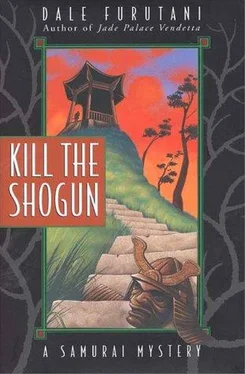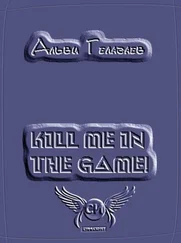Dale Furutani - Kill the Shogun
Здесь есть возможность читать онлайн «Dale Furutani - Kill the Shogun» весь текст электронной книги совершенно бесплатно (целиком полную версию без сокращений). В некоторых случаях можно слушать аудио, скачать через торрент в формате fb2 и присутствует краткое содержание. Год выпуска: 2011, ISBN: 2011, Жанр: Исторический детектив, на английском языке. Описание произведения, (предисловие) а так же отзывы посетителей доступны на портале библиотеки ЛибКат.
- Название:Kill the Shogun
- Автор:
- Жанр:
- Год:2011
- ISBN:0688158196
- Рейтинг книги:3 / 5. Голосов: 1
-
Избранное:Добавить в избранное
- Отзывы:
-
Ваша оценка:
- 60
- 1
- 2
- 3
- 4
- 5
Kill the Shogun: краткое содержание, описание и аннотация
Предлагаем к чтению аннотацию, описание, краткое содержание или предисловие (зависит от того, что написал сам автор книги «Kill the Shogun»). Если вы не нашли необходимую информацию о книге — напишите в комментариях, мы постараемся отыскать её.
Kill the Shogun — читать онлайн бесплатно полную книгу (весь текст) целиком
Ниже представлен текст книги, разбитый по страницам. Система сохранения места последней прочитанной страницы, позволяет с удобством читать онлайн бесплатно книгу «Kill the Shogun», без необходимости каждый раз заново искать на чём Вы остановились. Поставьте закладку, и сможете в любой момент перейти на страницу, на которой закончили чтение.
Интервал:
Закладка:
Ieyasu was surrounded by the chief architects of the castle and several daimyo, including Honda, Nakamura, Okubo, Toyama, and Yoshida. He was marching vigorously along the wall. The others trailed him, although Okubo, who had a limp, struggled in his efforts to keep up.
Ieyasu was generally pleased with how the castle was progressing, but didn’t let the pleasure show on his face. He had cultivated an image of stoicism and was very conscious of the role he believed he had to play in public.
They had been walking all morning. Ieyasu was famous for his potbelly, but he was also a strict believer in military training and discipline, and was known for his ability to walk, ride, and shoot a musket, all things he practiced diligently. He said that hawking was his favorite sport because it emulated some of the rigors of a military campaign. He was not tired by the inspection tour, but the architects were sweating. Of course, it was more than physical fatigue that had the architects sweating.
“As you can see, Ieyasu-sama, the progress on this part of the wall has been considerable,” the chief architect said.
Ieyasu made no comment and just stared at the man. The architect started sweating more profusely. The new Shogun demanded the best quality with all things military, including his new castle. He also demanded frugality. This was a combination difficult to achieve, and throughout the tour the Shogun had found fault with either quality or cost at almost every stop. As the absolute ruler of Japan, with the ability to put to death anyone he wished to, the Shogun was not a man the architect wanted to displease.
“What do you think, Okubo-san?” Ieyasu asked. He picked Okubo to comment first because he was still judging this man and wanted to hear his opinion before he had a chance to see how the other daimyo felt.
“I think only you, Ieyasu-sama, can be the judge of how pleased or displeased you are with the progress of this section of the castle.”
Ieyasu made no comment but noted that Okubo’s reply revealed nothing about his thoughts or feelings. That kind of reply could be a virtue, and it could also be something else. “And you, Honda?”
Honda looked at the walls on both sides of him and said gruffly, “It’s fine. Why do you make the poor architects sweat? Every castle costs too much and has problems.”
“And you, Nakamura-san?”
“I suppose one would have to compare the progress and cost of this part of the castle with the rest of the castle,” Nakamura began. “Then one sees if the relative progress here was better than the rest of the project. However-”
“Thank you, Nakamura-san,” Ieyasu broke in. “And what do you think, Yoshida-san?”
“I agree with Honda-san. The progress here is fine.”
Ieyasu secretly agreed, and he was pleased that Yoshida was so direct. Yoshida combined the intelligence of the new daimyo with the directness of Ieyasu’s Mikawa bushi, like Honda. Ieyasu liked him.
“And you, Toyama-san?”
“I believe-”
A sharp crack rang out. The daimyo, all experienced warriors, knew immediately it was the sound of a musket. Nakamura grabbed his chest and spun around, falling off the edge of the wall and tumbling like a rag doll down the sloping stone wall of the castle into the dry moat. Ieyasu looked down at Nakamura’s body and could tell from the way he landed that Nakamura was dead before he hit the earth.
“Protect the Shogun!” Yoshida shouted, and he followed his words with actions, stepping in front of Ieyasu to shield him. Seeing Yoshida’s example, Honda joined him in shielding Ieyasu as the other daimyo took Ieyasu behind the shelter of the wall. The Shogun shrugged off their urging hands and stalked off the wall at his own speed.
CHAPTER 3
The mighty make plans
as if they were immortal.
Worms still gnaw their bones.
It was a sign from heaven,” Toyama said. “The divine hand of the Gods, sparing Ieyasu-sama like that.”
“Ha! It was just a bad shot. If it was a sign from heaven, heaven was a bit hard on Nakamura-san,” Honda said.
Ieyasu entered the teahouse that had been constructed especially for this inspection tour. It was designed to allow the Shogun to rest and take some refreshments. He looked as phlegmatic as ever, although now he had a guard around him that waited at the door. Honda, Toyama, and Okubo were already in the teahouse, but, unlike the Shogun, they were still agitated by the incident.
“Are you all right, Ieyasu-sama?” Toyama asked.
“Of course,” Ieyasu said. Toyama’s excitement reminded Ieyasu that Toyama had relatively little battle experience. Ieyasu had been in over ninety battles and had survived several assassination plots.
Yoshida entered the teahouse and knelt on one knee in salute.
“Well?” Ieyasu said.
“I mobilized my men,” Yoshida said. “They’re already starting a search for the assassin.”
“Is Nakamura-san dead?”
“I’m sorry, Ieyasu-sama, but Nakamura-san has gone to the void. But we will find the assassins. My men are already talking to the soldiers who were guarding that portion of the crowd.”
“I appreciate your efficiency, Yoshida-san,” Ieyasu said.
Toyama said, “It must have been someone in the crowd. Surely they must have caught him. It was at least eighty paces from where we were to the edge of the crowd.”
“I shoot three shots with a musket every day for practice,” Ieyasu observed. “I agree an ordinary gun would not carry much beyond eighty paces, but I have killed a crane at one hundred twenty paces using a gun made by Inatomi Gaiki. If the assassin used such a gun, he could hide on the roof of the houses or the yagura. Have someone check this.”
Honda, who had been disturbed by Yoshida’s willingness to take charge, jumped in and said, “Of course, Ieyasu-sama. I’ll have my men look into this.”
Ieyasu noticed Honda’s willingness to be of help, but he said, “Yoshida-san’s men are already investigating. It would be best to let them finish the investigation, instead of having two groups do it.”
Clearly displeased, Honda said, “Yes, Ieyasu-sama.”
“I appreciate your standing in front of me to block any additional bullets,” Ieyasu said to Honda. “You and Yoshida-san acted quickly to shield me. It is the duty of every retainer to die to protect the life of his lord, but you two had presence of mind and acted quickly.” This was a rebuke to Toyama and Okubo, and Ieyasu could see their faces turn red.
“But Ieyasu-sama-” Toyama started.
“I don’t want to discuss it now.” Ieyasu said this in a calm voice, but Toyama was stopped in mid-sentence by the Shogun’s tone. Ieyasu noted with satisfaction that Okubo had enough sense to keep his mouth shut.
Yoshida excused himself to check on the housetops, and Ieyasu said, “Call the chief architect in to see me.”
The architect was hurriedly summoned. When he arrived, Ieyasu said, “I’ve decided we should expand the size of the castle. We should also publish decrees that no building or tower may be constructed which looks down into the castle.”
The architect was surprised that Ieyasu could be so calm after an assassination attempt and so interested in discussing military matters. Ieyasu was famous for always mulling over political and military matters. Once, during a dramatic moment in a Noh performance, an art Ieyasu was enough interested in to actually participate in performances, he leaned over to a daimyo and remarked, “I’ve been thinking, it’s just about time to cut the bamboo for military banners.”
“How much bigger do you want the castle?” the architect stammered.
“I think fourteen thousand paces for the outer wall will do.”
Читать дальшеИнтервал:
Закладка:
Похожие книги на «Kill the Shogun»
Представляем Вашему вниманию похожие книги на «Kill the Shogun» списком для выбора. Мы отобрали схожую по названию и смыслу литературу в надежде предоставить читателям больше вариантов отыскать новые, интересные, ещё непрочитанные произведения.
Обсуждение, отзывы о книге «Kill the Shogun» и просто собственные мнения читателей. Оставьте ваши комментарии, напишите, что Вы думаете о произведении, его смысле или главных героях. Укажите что конкретно понравилось, а что нет, и почему Вы так считаете.












